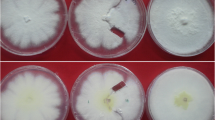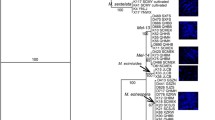Abstract
Ascocarp production byNannizzia otae, VUT 77054‘+’x VUT 77055‘−’, was compared on 8 different (1 keratinous and 7 non-keratinous) agar media.
Oatmeal salts agar and diluted Sabouraud dextrose salts agar with or without yeast extract were found to be unsuitable for ascocarp production in this species. In contrast, three different variants of oatmeal salts agar enriched with yeast extract proved to be satisfactory for the same purpose, while oatmeal salts agar with both yeast extract and horsehair powder was not necessarily superior to the former three media in this regard. Niger seed salts agar enriched with yeast extract was the most superior to any other seven media in all of the following respects; i.e., the number of gymnothecia produced per plate, the germination rate of ascospores, and the suppression of sporulation.
Asci from the cross VUT 77054‘+’ x VUT 77055‘−’ that yielded abundant fertile gymnothecia on niger seed salts agar with yeast extract were dissected and 51 ascospores were randomly isolated. Of the 51 ascospores, 47 (92%) germinated to form mature colonies. Of the 47 monoascospore F1 progeny back crossed to the parentals, 21 (45%) mated or reacted with the ‘+’ mating type, 18 (38%) did with the ‘−’ mating type, and the remaining 8(17%) were sexually nonreactive.
One hundred and twenty-three Japanese isolates ofMicrosporum canis, obtained from human and animal ringworms for the past 12 years, were also crossed with the tester strains ofN. otae on selected 3 of the 8 media to determine their mating type. Out of these 123, 113 (92%) produced fertile gymnothecia in crosses with VUT 77054 ‘+’, 9(7%) were non-reactive, and the only one isolated from human in Osaka city produced fertile gymnothecia in crosses with VUT 77055‘−’. The data suggest thatM. canis (N. otae) exists predominantly as ‘−’ mating type in Japan. A possible explanation for this unequal distribution of mating type is presented.
Similar content being viewed by others
References
De Vroey, C. 1964. Formes sexuées des dermatophytes. Production de cleistothéces de Microsporum gypseum (Bodin) Guiart et Grigoraki sur divers milieux steriles. Annales de la Société Belge de Médecine Tropicale (Bruxelles) 44: 831–840.
Hasegawa, A. & K. Usui. 1974. The perfect state of Microsporum canis. Jap. J. Vet. Sci. 36: 447–449.
Hasegawa, A. & K. Usui. 1975. Nannizzia otae sp. nov., the perfect state of Microsporum canis Bodin. Japan. J. Med. Mycol. 16: 148–153.
Hironaga, M. 1979. Studies on the Trichophyton mentagrophytes complex. J. Wakayama Med. Soc. 30: 11–28. (in Japanese with English summary).
Padhye, A.A., A.S. Sekhon & J.W. Carmichael. 1973. Ascocarp production by Arthroderma and Nannizzia species on keratinous species on keratinous and non-keratinous media. Sabouraudia 11: 109–114.
Takashio, M. 1969. Etude de certain facteurs nutritifs stimulant la reproduction sexée chez Arthrodema simii Stockdale et al. Bulletin de l'Academie royale de Belgique (classe de Science) 5e Séries 55: 842–852.
Takashio, M. 1972. Sexual reproduction of some Arthroderma and Nannizzia on diluted Sabouraud agar with or without salts. Mykosen 15: 11–17.
Takashio, M. 1973. Une nouvelle forme sexuée du complexe Trichophyton mentagrophytes, Arthroderma vanbreuseghemii sp. nov. Ann. Parasit. hum. et comp. 48: 713–732.
Takashio, M. 1973. Etude des phénomènes de reproduction liés an villissement et au rajeunissement des cultures de champignons. Ann. Soc. belge. Méd. trop. 53: 427–580.
Weitzman, Irene & Margarita Silva-Hutner. 1967. Nonkeratinous agar media as substrate for the ascigerous state in certain members of the Gymnoascaceae pathogenic for man and animals. Sabouraudia 5: 335–340.
Weitzman Irene & A.A. Padhye. 1978. Mating behavior of Nannizzia otae (= Microsporum canis). Mycopathologia 64: 17–22.
Author information
Authors and Affiliations
Rights and permissions
About this article
Cite this article
Hironaga, M., Nozaki, K. & Watanabe, S. Ascocarp production by Nannizzia otae on keratinous and non-keratinous agar media and mating behavior of N. otae and 123 Japanese isolates of Microsporum canis. Mycopathologia 72, 135–141 (1980). https://doi.org/10.1007/BF00572655
Issue Date:
DOI: https://doi.org/10.1007/BF00572655




